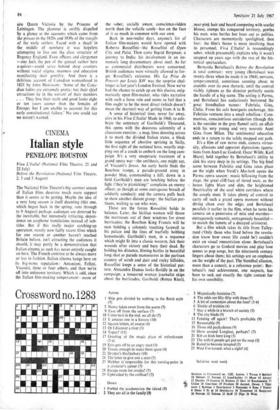Far-away places
ART ROY STRONG
Visiting Niagara Falls is a social solecism akin to having a crinoline lady over one's telephone, so the wife of a British High Com- missioner in Ottawa once told me. It is definitely the thing these days not to have visited places of such vulgar resort. In the past. however, one only had to get within half a mile of the spray to out with pen and brushes and reel off yet another watercolour for the family album. Plodding the corridors of the houses of descendants of governors-general, as has been my wont for the past two years, 1 have been staggered by the mounds of views of Wolfe's Cove, the falls of Montmorenci. of Chaudiere, St Anne's, Gasp4 and Trois Rivieres that have been exhumed. 'Europe in Canada,' the British Museum's tribute to the Dominion in her centennial year, captures a good deal of this relentless scribbling and doodling by discos erers, soldiers, colonial settlers and officials. This is a good, sober, documentary, historical exhibition of the type which art critics totally ignore as though Andy Warhol's plastic paint bombs alone qualify for their holy writ: The set for the exhibition was struck initially for 'Poetry in the Making,' but the muddy green felt screens form as good a foil for the brie-à-brae of Canadiana as before they served to frame the tattered scraps of Eliot and 1.arkin. Leftover bay trees and the presiding,
meditating, Roubiliac of Shakespeare jar, how- ever, a little; a bit like utilising the stage props from Hamlet for The Dancing Years. The ex- hibition opens with a pretty ravishing piece of manuscript illumination. a sensational map by John Rutz recording Jacques Cartier's dis- cos ery of Canada. The reason why this turns up tucked away among the Royal Manuscripts is a simple one, for Rot/. entered Henry V111's service, having worked in Dieppe where cartographers first assimilated Cartier's astound- ing discoveries. And the chaps in blue smocks :e.;ping up and down waving bows and arrows near thatched cones akin to advertisements for the Club Mediterranee are the earliest attempts of any European to draw Indians and wigwams.
Understandably the exhibition is thin on New France, although there are some hand- some illustrated editions of Champlain's voyages • and the hair-raising Jesuit Relations, but the real star turn is the 'Red-lined Map,' the most important in the history of the North American continent. Recording the vagaries of frontier after the Treaty of Utrecht in 1713, it carries !he manuscript annotations by which we recog- nised the independence of the thirteen southern states at the peace of Versailles in 1783.
With the collapse of New France in 1759 and the loss of the New England states came the opening up of Canada and British efforts it systematic, widespread colonisation. Gover- nor Simcoe's wife, Elizabeth Posthuma, cap- tures very well the mood of these Britishers who paddled from lake to lake marking pos- sible places for townships. She had 'the pic- turesque eye' and along with the thirty-odd Canadian views on birch bark [sic] presented to George III she includes Chepstow Castle, copied from that high priest of the picturesque, the Rev William Gilpin. No wonder so many of the views of Canada by her, Edy, Parkyns, Pcachey and the rest of them evoke the word pictures of Mrs Radcliffe describing Alpine scenery in The Mysteries of Udolpho. Water- falls crash down ravines, trees trail in limpid waters, cliffs of rock rise to fantastic heights and one peers down on to idyllic tiny towns from hillsides embowered with greenery. It is all `awe,' terror' and 'sublime,' the kind of scenery we associate these days with Hammer films.
This whiff of heavy romance is accentuated by George Ill's son, Kent, living it up with his mistress, Mme de St Laurent, in Halifax, Nova Scotia, until rushed back to England to
sire Queen Victoria by the Princess of Leiningen. The glamour is swiftly dispelled by a glance at the accounts which came from the presses in the 1820s and 1830s of the travails of the early settlers. Faced with a -shade-in the middle of nowhere it was hopeless attempting to live out the class structure of Regency England. Even officers and clergymen —one feels the pen of the genteel author here a-quiver—could serve behind shop counters without social stigma. manners and education manifesting their gentility. And there is a delirious account of Canadian womanhood in 1821 by John Howisson : 'Some of the Cana- dian ladies are extremely pretty; but their chief attractions lie in the naiveté of their manners . . . They lose their teeth and good looks eight or ten years sooner than the females of Europe; but I am unable to account for, this early constitutional failure.' No one could say we weren't warned.































 Previous page
Previous page